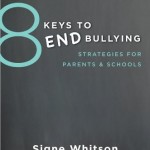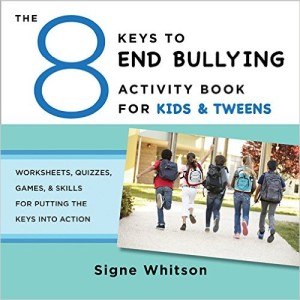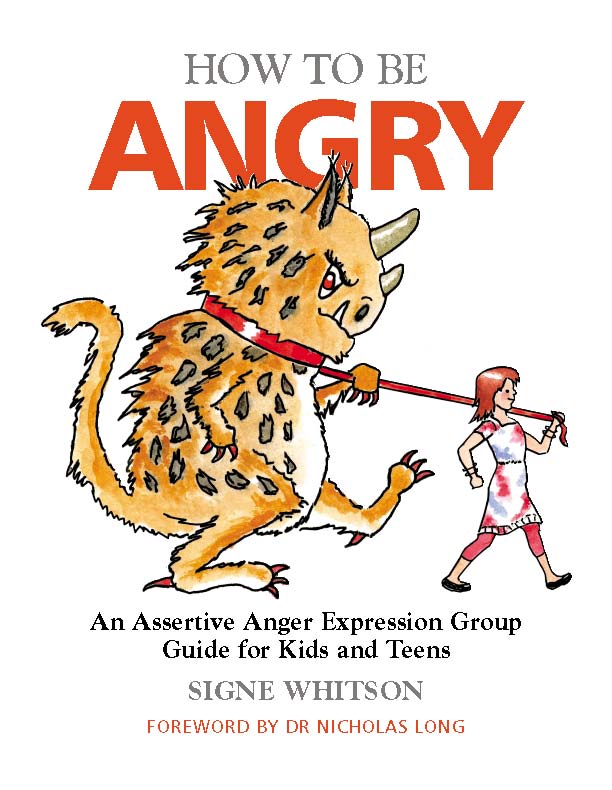bullying
Bullying Prevention Grant for Teachers
0Study.com is offering a new funding opportunity to help teachers with bullying prevention.
The Study.com Grant offers $1,000 to two teachers each year to spend on resources and materials they need to promote safe, positive relationships among students. Specifically:
- $1,000 to spend on training, curriculum materials, or other resources to support bullying prevention, and
- a 12-month subscription to Study.com’s videos, worksheets, lesson plans, and more.
Full details can be found on the Study.com Grant for Teachers here.
Applications are accepted on a rolling basis. The first application deadline is March 1, 2019, and the second deadline is December 1, 2019.
Addressing Bullying in School
0In this week’s Classroom Q&A, Education Week’s Larry Ferlazzo asks:
How can teachers and administrators best address bullying in school?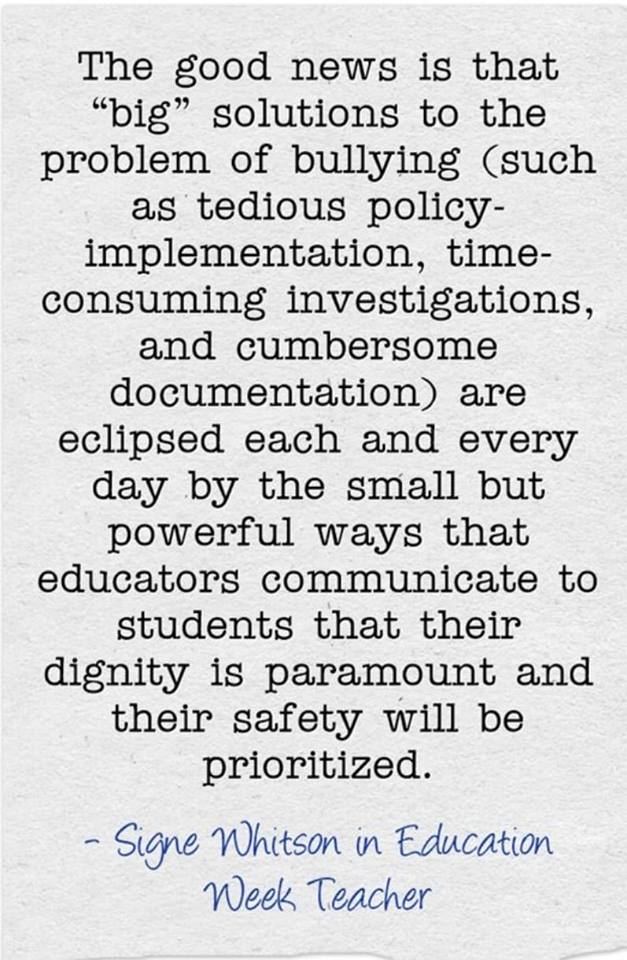
Here’s my response, based on material from my book, 8 Keys to End Bullying: Strategies for Parents & Schools.
The good news is that “big” solutions to the problem of bullying (such as tedious policy implementation, time-consuming investigations, and cumbersome documentation) are eclipsed each and every day by the small but powerful ways that educators communicate to students that their dignity is paramount and their safety will be prioritized. The hopeful news is that while there is no single cure-all to cruelty, there are all kinds of simple, focused, quick, and accessible strategies that administrators and teachers can use to bring an end to bullying in their schools and classrooms. Best news yet: Most of these bullying prevention strategies simultaneously build more positive relationships between students and staff.
What follows are 8 small (in terms of daily time commitment) yet big (in terms of their effectiveness) strategies teachers and administrators can use to address bullying in schools:
1. Understand the differences between “rude,” “mean,” and “bullying” behavior . Intervene accordingly.
2. Recognize the warning signs of a child who is being bullied. Reach out to young people who bully others. Insist that all young people are worthy of help and guidance from a caring adult.
3. Prioritize positive relationships between staff and students. When young people feel connected to adults, they are less likely to bully others and more likely to report incidents of bullying.
4. Create cultures of kindness in your school. Compassion, kindness, and empathy are the antidotes to cruelty, social exclusion, and bullying.
5. Reject the “kids will be kids” mentality. Bullying is never just a “rite of passage” for young people; it is an abuse of power. Kids need adult help in order to restore healthy power balances among peers.
6. Bullying tends to happen in the places and spaces where adults are absent. Increase adult presence in social spaces including hallways, locker rooms, recess, and the bus. Eat lunch with kids. Simply “being there” can significantly reduce the incidence of bullying in schools.
7. Make bullying prevention an everyday activity;not just a once-and-done assembly or week-long poster contest. Integrate bullying-prevention activities into daily routines, such as morning meetings, advisories, buddy systems, lunchtime seating arrangements, and more.
8. Establish a partnership with parents about bullying-prevention practices. Work with families to create guidelines for their kids’ social-media use and set shared standards for how kids must treat each other online.
For more responses to Larry Ferlazzo’s question, please visit the entire post on Education Week.
For more information and training opportunities, click here.
– ———————————————————————————————– –
Bullying Prevention Efforts in Elementary School
0Sesame Street Tackles Bullying
0As an independent, nonprofit organization; programs like Sesame Street and Autism: See Amazing in All Children would not be possible without charitable giving. If funded, Sesame Workshop will tackle another major issue for families in the autism community and beyond: how to prevent bullying by fostering empathy and compassion.
Childhood bullying hurts, and research shows that kids with autism are disproportionately affected. Since 2015, Sesame Workshop has reached millions of kids and families with their work in the autism community. However, in order to tackle bullying prevention, Sesame Workshop is looking to their passionate community of fans and families for help. If the campaign’s first funding goal is reached, Sesame Workshop aims to create a kid-friendly digital storybook about understanding differences through everyday activities and play – plus articles and supplementary materials about bullying for grown-ups.
As with other materials and storybooks featuring Julia, this new content will offer parents and caregivers a perfect starting point for deeper conversations with their children. Here are some fun videos to check out:
Julia and Rosita Celebrate Families
Julia and Grover Search for Patterns
Julia, Rosita and Grover Play Freeze Dance
If you’d like to help fund Sesame Workshop’s endeavor to bring an end to bullying, please visit their Kickstarter page here: https://www.kickstarter.com/projects/sesamestreet/help-prevent-bullying-with-sesame-streets-autism-i?ref=user_menu
School-Based Bullying Prevention Programs
0What a wonderful day I spent at Immaculate Conception Cathedral School in Lake Charles, LA. yesterday! Here’s a few shots from our 5th/6th grade workshop, where the kids and I looked at key differences between rude, mean, and bullying behavior, then brainstormed helpful ways to respond to each.
Thanks also to the dedicated faculty and wonderful parents with whom I also got to share practical strategies for bringing an end to bullying.
To book your school-based event, click here. Now booking for Spring and Summer 2018.
Bigger Than The Playground: Dealing With Cyberbullies After The Big Move (Guest Post)
0Today, I share a Guest Post from Laura Pearson, a Mom who writes about her experiences supporting her son after the family’s move to a new town:
Moving to a new town and attending a new school can be one of the hardest things your child will experience before entering adulthood. They will have to leave all of their friends, teachers and familiar places behind before completely readjusting to something new.
An article published by Psychology Today claims that children who have recently moved can exhibit poor performance in school, bad behavior, drug abuse, and many other maladies. On top of all of that, things like cyberbullying the “new kid” can be rampant.
According to the Cyberbullying Research Center, nearly 28 percent of middle schoolers and high schoolers experienced cyberbullying between May of 2007 and August of 2016. PBS reports that nearly 1 in 3 kids say they’ve experienced cyberbullying.
But what exactly is cyberbullying, anyway?
According to the National Crime Prevention Council (NCPC), cyber bullying is similar to other types of bullying, except that it takes place online over emails and text messages. Some examples of cyberbullying include: sending someone mean or threatening emails, instant messages or text messages; tricking someone into revealing personal information and sending it to others; and creating a website to make fun of another person. Unlike in-person bullying, cyberbullying can take place 24 hours a day, even when your child is alone.
A 2015 article by Scientific American confirmed a direct correlation between cyberbullying and an increased likelihood of depression among children. There have even been instances in the news where a child was cyber bullied to such an extent that they took their own lives.
So what can we do to help our child if they are being cyber bullied?
For parents, it is important to know what sites your child is visiting and to understand who they are interacting with. According to stopbullying.gov, this is the first step for parents to take in order to prevent cyberbullying before it starts. Establishing rules with your children about what sites they visit and what activities they engage in can help eliminate potentially harmful conditions.
The best thing for your child to do if they are being cyber bullied is to not respond to the attacks of a cyber bully and to block them using the privacy features of your E-Mail or messaging. Any response to the bully from your child can be easily circulated and prolong the confrontation. Be sure to save all bullying emails and texts, and send them to your Internet Service Provider (ISP). Remember that bullying and cyberbullying can be a crime if they are threatened with violence or harassed based on their gender or race. Although technology provides another avenue for children to be bullied, it also provides accurate records and features that can yield an effective defense against it, legally or otherwise.
It is also beneficial to create a stress-free home environment for your child if they are experiencing cyber bullying, especially after moving to a new place. Start off by creating stability in your new home that your child can come to rely on, such as a weekly game nights or pizza every Friday. Try to de-clutter your home environment and make it organized so that your child knows where everything is if they need it. It is also helpful to foster clear and loving communication with your child in your home so that they know they have a safe haven from any sort of bullying or negativity, and so that they can share with you when something is wrong. In many instances, children will feel embarrassed and not want to share the fact that they are being bullied.
By being aware of your child’s online activity and having open communication about what to do if they are being bullied online, parents can help their children thrive after moving to a new town or city.
For more information, please visit Laura Pearson at Edutude.net or email her: laura@edutude.net
Fun Activity Helps Kids Tell the Difference Between Bullying and Other Forms of Conflict & Aggression
0In my book, 8 Keys to End Bullying: Strategies for Parents & Schools and in this article featured online in Psychology Today, I make a distinction between behaviors that are rude, behaviors that are mean, and 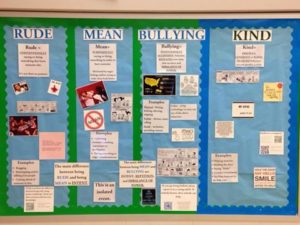 behaviors that are true examples of bullying. I explain why it is critical that parents and professionals are able to discern the differences between these troubling behaviors and explain the risks of lumping all bad behaviors under the bullying umbrella.
behaviors that are true examples of bullying. I explain why it is critical that parents and professionals are able to discern the differences between these troubling behaviors and explain the risks of lumping all bad behaviors under the bullying umbrella.
I created the activity below for educators, counselors. social workers, school psychologists, youth workers and parents to use with kids to help them learn and integrate behavioral definitions of rude, mean, and bullying. Please feel free to use this activity with the young people in your life to teach them about the key distinctions between these three behaviors. (I do ask that you include my name and contact information if you make photocopies of this activity or use it in any type of presentation.
ACTIVITY: Is it Rude, Is it Mean, or Is it Bullying?
After reviewing the distinctions between rude, mean, and bullying behavior (below), read the following scenarios aloud to kids. Challenge kids to move to a designated section in the room if the behavior represents bullying, to a different section if the behavior demonstrates meanness, and to a third section if the behavior is considered rude. Allow kids time to discuss why they chose to stand in a particular section, encouraging personal examples and reflection, as appropriate. An Answer Key is provided to guide your discussion.
DEFINITIONS:
Rude = Accidentally saying or doing something hurtful.
Rude behaviors include:
- Burping in someone’s face
- Butting in line
- Bragging about making a team
Rude behaviors are usually thoughtless and ill-mannered, but not meant to actually hurt someone else.
Mean = Saying or doing something to hurt a person on purpose, once or maybe twice.
The main difference between “rude” and “mean” behavior is that rudeness is usually unplanned. Mean behavior, on the other hand, is done on purpose.
Mean behaviors include:
- Making fun of what someone looks like or what they are wearing
- I don’t like your short hair. You look like a boy.
- Why did you wear that dress?
- Insulting someone’s intelligence or ability
- You’re so stupid.
- You stink at soccer.
- Saying or doing something unkind after a fight with a friend.
- Saying, “I hate you.”
- Taking something that doesn’t belong to you.
Make no mistake; mean behaviors are very hurtful and should be avoided at all times! Still, meanness is different from bullying in important ways that we’ll talk about next.
Bullying = Cruel behavior, done on purpose and repeated over time, that involves an imbalance of power.
To best understand bullying, remember the 3 P’s:
- It is done on Purpose; there is nothing “accidental” or unplanned about bullying
- It is a Pattern; the cruelty happens over and over again
- It is all about Power; the cruel person has more control and influence than his/her target
Kids who bully say or do something purposefully hurtful to others and they keep doing it again and again, with no sense of guilt or shame. Kids who bully have more power than the kids they pick on. This power may come from being older, stronger, or bigger in size or it may come from getting several kids to gang up on one target, to make that target feel hurt and alone.
SCENARIOS:
- Kayla tells MacKenzie that she can’t sit with her on the bus today because she is saving the seat for a girl from her Social Studies class.
- Lucas tells Damien that he can’t play with the Legos because he is the worst builder in the whole first grade.
- Talia makes plans to go to the school dance with her new friend, Gwen. Katie tells Talia that if she hangs out at the dance with Gwen that everyone will think she is a total weirdo and no one will like her anymore. At lunch that day, Katie convinces everyone that it would be a really funny joke to all laugh out loud when Talia approached the lunch table.
- Devin and David are friends. In school, they had an argument. Devin called David a name and David shoved him out of his way.
- Maggie is making fun of the fact that Jessie hangs out with the boys at recess and wears long basketball shorts to school every day. In gym class, Maggie told her to go play on the boys’ team and the day before in homeroom, she wrote the words “You’re so gay” on Jessie’s desk.
- Brady told JP he would beat him up if he touched his cars, then shoved JP out of his way. During math class, he threw a spitball at JP and kicked his chair out from under him. He threatened to punch JP if JP told the teacher.
- Emma and Brit play on the same field hockey team and are normally best friends, but have been in an argument for three days. Emma called Brit a mean name after practice and Brit send Emma a mean text.
ANSWER KEY
- Kayla & MacKenzie: Kayla is being rude, but here is no evidence of intentional meanness, repetitive behavior or a power imbalance.
- Lucas & Damien: Lucas is being mean. It appears that his words are intended to hurt Damien. There is no evidence of repetitive behavior or a power imbalance, however.
- Talia & Katie: Katie is acting like a bully. She has creating an unfair balance of power by getting all of the girls at the lunch table to laugh at Talia. She is also using words like “everyone” and “no one” to threaten Talia about how she will be socially excluded if she does not do what Katie wants her to do.
- Devin & David: Devin and David are engaging in rough play, or rude behavior. This is not bullying because the boys are usually friends, the power balance is relatively equal and the boys are not intending to harm each other.
- Maggie & Jessie: Maggie is acting like a bully. She is making fun of Jessie repeatedly, with intention to cause harm. Slurs based on sexual orientation are particularly cruel for young people and should be taken seriously by adults wishing to create a positive school culture.
- Brady & JP: Brady is acting like a bully. He is engaging in repetitive cruel behavior, designed to hurt JP. He is using intimidation and threats to create a power imbalance.
- Emma & Brit: Emma and Brit are being mean to each other. They are intending to hurt each other with their words and texts. The girls are normally friends, though, and at this point, this appears to be a mutual argument rather than a repetitive pattern of one-sided cruelty.
If you know a young person who would benefit from exploring the distinctions between rude, mean, and bullying and/or who would like to learn skills for managing conflict and bullying check out the 8 Keys to End Bullying Activity Book for Kids & Tweens. This book (and Companion Guide, sold separately or as a set) provides dozens of worksheets, quizzes, activities, puzzles, and skill-building games to teach these concepts and much, much more. Check it out here!
5 Do’s and Don’ts of Helping Kids Handle Bullying
0One of the most common reasons parents approach me is to ask for my advice on how to help their child handle a bullying situation at school. Fear for their child’s well-being combined with a sense of powerlessness at changing peer dynamics often leaves moms, dads, and other caregivers feeling helpless. The bad news is that conflict and bullying are pervasive among school-aged kids and most students will be impacted by physical or social aggression either directly or indirectly. The good news is that there are many, many ways that parents can help safeguard their children and positively impact kids’ relationships. Here are five of the simplest—yet most powerful—do’s and don’ts parents can use to help their kids handle conflict and bullying:
1. Words Matter
Do help kids understand the difference between unintentionally rude behavior (such as butting ahead in the lunch line), mean comments said in a moment of anger between friends (e.g. “You’re not my best friend anymore”), and bullying behavior that is characteristically marked by purposeful cruelty that is repeated over time and involves an abuse of power (whether that power be size and strength or social rank at school.)
Don’t allow kids to over-label rude and mean behaviors as ‘bullying.’ In recent years, gratuitous references to bullying in schools and communities have created a “little boy who cried wolf” phenomena, resulting in jaded adults failing to take action when needed and vulnerable children missing out on the adult support they desperately need.
2. Conflict is OK
Do teach your child that it is perfectly normal to disagree with a friend. Differences of opinion are perfectly acceptable and learning how to communicate them respectfully is a critical social skill.
Don’t worry that you’re too much of a helicopter parent if you intervene in your child’s friendship conflict. Kids are not born knowing how to resolve conflict (goodness knows too many people make it to adulthood without this knowledge!). Young people need supportive adults to coach them in how to disagree without arguing and how to apologize after they’ve behaved badly.
To read the rest of the article, please visit Signe’s blog on Psychology Today.
When Kids Make Mistakes Online: A Story of Social Media Frenemies
0During the elementary school years, most kids are very aware of technology but still quite naïve about all of the hurtful ways in which it can be used. Well into their adolescence even, many kids remain oblivious to the legal consequences of their online actions. This real-life example of innocence-gone-awry by way of technology underscores that one of the most important things adults can do to bring an end to cyberbullying is to teach young kids about the risks of their online behavior and to give them skills to protect themselves from lasting harm.
For the full article, please click here or paste this link into your browser: http://www.huffingtonpost.com/signe-whitson/what-happens-when-kids-ma_b_5953026.html
New Review of How to Be Angry
0A middle school Special Education teacher from Wisconsin recently reviewed my book, How to Be Angry, on her blog, Half-Past Kissin’ Time and on Amazon. She has some great insights about using the book with tweens and teens. Please check her review out here:
http://www.halfpastkissintime.com/2013/08/how-to-be-angry.html




